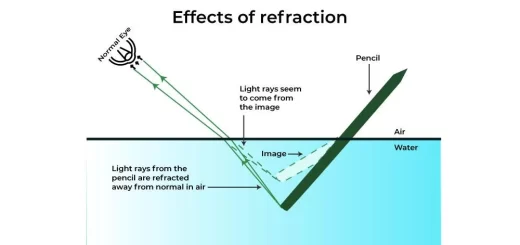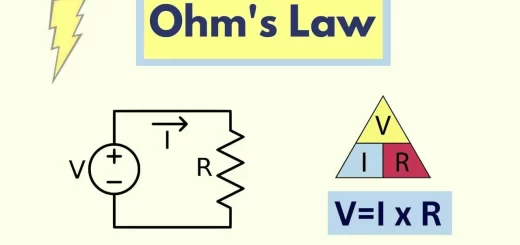Mutual induction between two coils and applications of the self induction of a coil
If two stationary coils are arranged such that one coil surrounds the other, A coil is plunged into the second one, or even one is placed in the neighborhood of the other, then the variation in the intensity of the electric current in one of them (opening or closing the switch) will induce the electromotive force in the other coil.
Experiment to study the mutual induction between two coils
Steps:
- Connect a coil with a battery, switch and a rheostat (Primary coil).
- Connect the second coil with a sensitive galvanometer having its zero reading at the middle of its graduated scale (Secondary coil).
- Switch off the circuit of the primary coil while it is inside the secondary coil.
Observation:
- The needle of the galvanometer deflects in a certain direction.
- Switch on the circuit of the primary coil, so the needle of the galvanometer deflects in the opposite direction.
- Move the primary coil away from the secondary coil, so, the needle of the galvanometer deflects in a certain direction.
- Keep the primary coil stationary inside the secondary coil and increase the electric current intensity in the primary coil, the needle of the galvanometer deflects in a certain direction.
- Decrease the electric current intensity in the primary coil, so, the needle of the galvanometer deflects in the opposite direction.
Conclusion: Induced emf can be generated in the secondary coil by the effect of another primary coil.
Back induced electromotive force and back induced current
When the produced magnetic field intensity in the primary coil increases, the induced magnetic field in the secondary coil will be in the opposite direction to resist the increase in the intensity of the acting magnetic field.
Cases of generating back induced electromotive force:
- Bringing the primary coil close to the secondary coil or when the primary coil is plunged inside the secondary one.
- Increasing the intensity of the current in the primary coil.
- Switching on the primary circuit during the presence of a primary coil inside or close to the secondary coil.
Forward induced electromotive force and forward induced current
When the produced magnetic field intensity in the primary coil decreases, the induced magnetic field in the secondary coil will be in the same direction to resist the decrease in the intensity of the acting magnetic field.
Cases of generating forward induced electromotive force:
- On withdrawal of the primary, or taking it far away from the secondary coil.
- On decreasing the intensity of the current in the primary.
- On switching off the primary circuit during the presence of a primary coil inside or close to the secondary coil.
Mutual induction between two coils is the electromagnetic interaction between two coils kept close to each other (or one inside the other) when an electric current with time-varying intensity passes in one coil (primary coil) that produces in the second one (secondary coil) an induced current in a direction such that to oppose the variation of the current intensity in the primary coil.
Deduction of the coefficient of mutual induction between two coils:
When the electric current intensity in the primary coil varies in a time rate of (ΔI1/Δt), the generated induced (emf)2 is directly proportional to the rate of change of the magnetic flux in it:
( emf )2 ∝ ΔΦm/Δt
ΔΦm/Δt ∝ ΔI1/Δt
( emf )2 ∝ ΔI1/Δt
( emf )2 = Constant × ΔI1/Δt
( emf )2 = − M × ΔI1/Δt
Where: M is the coefficient of mutual induction between two coils
∴ M = − (emf)2 / (ΔI1/Δt)
The negative sign means that the induced electromotive force opposes the change causing it Lenz’s rule, The unit of the coefficient of mutual induction is (Henry).
Coefficient of mutual induction between two coils (M) is the induced electromotive force generated in one of the two coils when the electric current intensity in the other coil changes in the rate of 1 Ampere every second.
Henry is the coefficient of mutual induction between two coils that, if the electric current intensity at one of them is changed in the rate of 1 Ampere every second it generates between the ends of the other coil induced emf of 1 Volt.
When the coefficient of mutual induction between two coil = 0.3 Henry, It means that if the electric current intensity in one of the two coils has changed in the rate of 1 A every second it generates induced emf of 0.3 Volt in the other coil.
The factors affecting the mutual induction between two coils:
- The magnetic permeability coefficient of the medium (presence of an iron core inside the two coils).
- The volume of the two coils (length of the coil and turn area).
- The number of turns of the two coils.
- The separating distance between them.
Self-induction
If a coil is connected to an electric circuit, then a change in the electric current intensity in that coil will generate induced emf that resists its change, Self-induction is the electromagnetic effect induced in the same coil when the electric current intensity increases or decreases, this effect acts to resist such a change in the intensity of the current.
Experiment to study the self-induction of a coil
Steps:
- Connect a coil of a strong electromagnet (a coil of a large number of turns) in series with 6 V battery, switch and a neon lamp (works at 180 V) in parallel.
- Switch on the circuit so the current passes in the considered coil.
Observation: Neon lamp does not glow, Switch off the circuit, so, An electric spark is passed between the two terminals of the switch and the neon lamp glows for a very short period of time.
Conclusion: When the circuit is switched on, a small induced back electromotive force is generated in the coil that delays the original current to reach its maximum value, due to the formation of a strong magnetic field, since each turn acts as a small magnet, the magnetic flux links with the neighboring turns.
When the coil circuit is switched off, the current ceases to pass in it and a large induced electromotive force is generated in the coil due to its big number of turns (emf ∝ N) and the high rate of change of the electric current intensity (emf ∝ ΔI/Δt).
Thus, an induced forward electric current is generated in the same direction as the original current passes in the form of a spark between the switch terminals, this is due the decrease in the current that leads to the generation of a large induced emf between the terminals of the coil by self-induction because of the large number of turns of the coil (emf ∝ N) and the large rate of change of current (emf ∝ ΔI/Δt).
So, a forward induced current is generated in the same direction of the original current that passes in the form of spark between the ends of the switch.
In the self-induction experiment, the forward induced emf in the coil is always greater than the back induced emf generated in it, because the rate of current vanish is always greater than the rate of current growth.
The wires of the standard resistors are wound to avoid the effect of self-induction in the wires where the induction due to the flow of current in any turn cancels the induction due to the flow of current in the opposite direction in the adjacent turn.
Deduction of the self-induction coefficient in a coil
The induced emf is directly proportional to the rate of change of the magnetic flux.
emf ∝ ΔΦm/Δt
The time rate of the change of the magnetic flux is proportional to the time rate of the change of the current.
ΔΦm/Δt ∝ (ΔI /Δt)
∴ emf ∝ ΔI / Δt
emf = Constant × ΔI / Δt
emf = − L × ΔI / Δt
L = − emf / (ΔI / Δt)
Where: L is the self-induction coefficient of the coil, The negative sign means that the induced electromotive force opposes the change causing it Lenz’s rule.
The unit of the coefficient of self-induction is Henry and it is equivalent to Volt.second/Ampere or Ohm.second or Weber/Ampere or Tesla.meter²/Ampere.
Coefficient of self-induction in a coil (L) is the induced electromotive force generated between the terminals of a coil when the electric current intensity in that coil changes in the rate of 1 Ampere every second.
Henry is the coefficient of self-induction in a coil when the electric current intensity in that coil changes in the rate of 1 Ampere every second and generates induced emf of 1 Volt between its ends.
When the coefficient of self-induction in a coil = 0.01 Henry, It means that if the electric current intensity in the coil is changed in the rate of 1 A/s it generates induced emf of 0.01 Volt between its ends by self-induction.
The self-induction coefficient of a coil can be calculated from the following relation: L = μ A N²/ l
Where: (μ) is the magnetic permeability of the medium, (A) area of the turn of the coil, (N) is the number of turns of the coil, (l) is the length of the coil.
The factors affecting the self-inductance of a coil:
- Cross-section area of the coil (A), directly proportional.
- Square of the number of turns (N²), directly proportional.
- The magnetic permeability of the medium (μ) that is constant for every certain medium, directly proportional.
- Length of the coil (l), directly proportional.
Applications of the self-induction of a coil
Fluorescent lamp
Fluorescent lamp is used in lighting, The magnetic energy is stored in a coil, This energy is discharged in an evacuated tube filled by an inert gas, causing collisions of its atoms and their subsequent ionization and collision with the walls of the tube which is coated with a fluorescent material that leads to the emission of the visible light.
Eddy currents
If the number of magnetic flux lines is changed through a solid conductor, then induced electric currents will be generated in closed paths in the solid conductor, such currents are called eddy currents and it causes a rise in temperature of the conductor.
Eddy currents are induced electric currents that are generated in a metallic piece due to cutting a variable magnetic flux, They are used in induction furnaces for melting metals.
The conditions of occurrence: moving a metal piece in a stationary magnetic field or by subjecting the metallic solid to a variable magnetic field.
Disadvantages: Loss of electric energy in the form of heat energy.
Electromagnetic induction, Faraday’s law and self-induction coefficient in a coil
Alternating current generator (Dynamo)-AC Generator & Effective value of the alternating current



